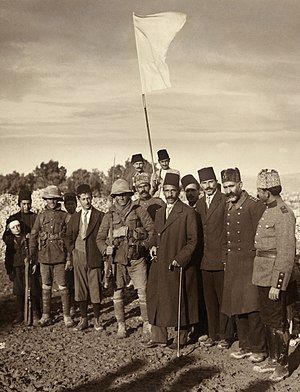Portal:Palestine/Selected picture
Usage[edit]
The layout design for these subpages is at Portal:Palestine/Selected picture/Layout.
- Add a new Selected picture to the next available subpage.
- Update "max=" to new total for its {{Random portal component}} on the main page.
Selected pictures list[edit]
Portal:Palestine/Selected picture/1

The Mayor of Jerusalem Hussein al-Husayni (centre) meets with soldiers of the British Egyptian Expeditionary Force on December 9, 1917, under the white flag of surrender. The Battle of Jerusalem had begun the day before, but the Turkish forces in the city were no match against the British forces. A Turkish counterattack on December 25 was also repulsed, confirming the capture of Jerusalem by the Allies.
Portal:Palestine/Selected picture/2

Ottoman machine gun corps, before the Second Battle of Gaza, which took place on 19 April 1917. The First Battle of Gaza, just three weeks prior, had ended in defeat for the British Empire, and this second attempt to break through Turkish defenses was also unsuccessful. Six months later, on the third attempt, the Allied forces were finally able to break the Gaza–Beersheba line.
Portal:Palestine/Selected picture/3

The Jerusalem Railway Station c. 1900. The locomotive on the turntable is "Ramleh" (J&J No. 3), a Baldwin 2-6-0. The station was the terminus of the Jaffa–Jerusalem railway until its closure in 1998. Today, the station is abandoned and suffering from neglect and vandalism, although it is one of 110 buildings selected for preservation in Jerusalem.
Portal:Palestine/Selected picture/4

A view of Jerusalem in the early 20th century. The earliest verified reference to the city is in the Amarna letters, which date to the 14th century BCE. Over its long history, it has been controlled by Israelites, Judaeans, Babylonians, Persians, Greeks, Hasmoneans, Romans, Byzantines, Arabs, Mamluks, Turks, and the British before being split between Israel and Jordan. Israel captured East Jerusalem in the Six-Day War of 1967, and the city remains a core issue in the Israeli–Palestinian conflict.
Portal:Palestine/Selected picture/5

Tanzanians protesting the 2008-2009 Gaza bombardment.
Portal:Palestine/Selected picture/6

A Bedouin woman in Jerusalem, sometime between 1898 and 1914, dressed in Palestinian costume, the traditional clothing worn by Palestinians. Many of the handcrafted garments were richly embroidered and the creation and maintenance of these items played a significant role in the lives of the region's women. Until the 1940s, traditional Palestinian costumes reflected a woman's economic status, whether married or single, and the town or district of origin, and a knowledgeable observer could glean such information from the fabric, colors, cut, and embroidery motifs (or lack thereof) in a given woman's apparel.
Portal:Palestine/Selected picture/7

The Ottoman camel corps at Beersheba before the First Suez Offensive of World War I. Although the main thrust of the offensive on February 3, 1915, was unsuccessful in capturing the Suez Canal, the Ottoman army achieved its objective because the British were forced to keep more troops in Egypt than they had expected.
Portal:Palestine/Selected picture/8

A young woman from Ramallah, c. 1898-1914. Until the 1940s, women of Palestine wore elaborate handcrafted garments. The creation and maintenance of these items played a significant role in their lives. A knowledgeable observer could determine a woman's village of origin and social status from her clothing. The circular band near this woman's forehead is a ring of coins made from a portion of her dowry money, and indicates that she is unmarried.
Portal:Palestine/Selected picture/9

Beit Sahour (lit. Place of the Night Watch) is a Palestinian town east of Bethlehem under the administration of the Palestinian National Authority. The population of 12,367, is Christian and Muslim.
Portal:Palestine/Selected picture/10

The Dome of the Rock is an Islamic shrine and a major landmark located in Jerusalem.
Portal:Palestine/Selected picture/11

An 1890 map of Palestine as described by medieval Arab geographers, with Jund Filastin administrative area.
Portal:Palestine/Selected picture/12

Nablus, the second largest city in the West Bank after East Jerusalem.
Nominations[edit]
Feel free to add related featured pictures to the above list. Other pictures may be nominated here.
File:Palestine under the Persians Smith 1915.jpg The West Bank under Persian rule
